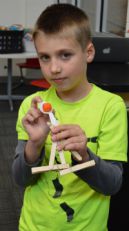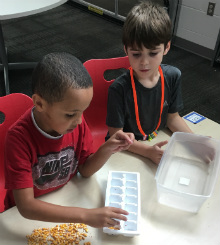Using kernels of knowledge gained from teacher Sherri Newenhouse, Brown Elementary School students participated in an “a-maize-ing” project: helping farmer Marc Van Dyk estimate his corn yield.
During the new Science, Technology, Engineering and Math (STEM) class, kindergarten through fourth-grade students broke corn off ears, which Newenhouse gathered from Van Dyk’s Hudsonville farm. They first estimated how many kernels were on each ear, and then tallied the actual total. Their findings: the average ear of corn has 576 seeds on it. Most students estimated closer to 100.

Students discovered different ears of corn had varying numbers of kernels. They added the total from each ear to find the average, Newenhouse said. To estimate his yield, Van Dyk would have to take that number and multiply it by how many plants he has.
“We had to count the corn so they can see how much they have to sell,” explained fourth-grader Aiden Vermurlen.
While Van Dyk uses a formula that’s a little more extensive to estimate his yield, he said he was impressed by the students’ work.

“I thought it was a great exercise,” he said. “I thought it was refreshing that they used something that was very common and they could use it in math and science.”
Students returned the corn to the farm, where it was thrown in the combine for harvesting.
Newenhouse explained another lesson from the project. “This isn’t just in our classroom. she told the class. “This is someone’s real life, and their job and their life depends on how much corn grows on these plants.”

Design, Test, Tweak
The new STEM class brings learning to life in other ways students appreciate, such as: designing catapults from spoons and rubber bands to send candy pumpkins flying; building popsicle-stick bridges; and discovering how to support a heavy book with a single sheet of paper. Newenhouse wants them to learn about trial and error.
“A lot of engineering (activities) involve going through that whole engineering process of brainstorming, designing it, testing it and then rethinking what they need to fix and redesign,” she said. “And of course they have to work together.”

The class ties in with Next Generation Science Standards, a set of teaching guidelines for kindergarten through 12th-graders outlined in “A Framework for K-12 Science Education.” The standards were adopted by the Michigan Department of Education last year. NGSS emphasizes student-led learning and that experiments are not cut and dry. Students redesign, rebuild and tweak as many times as it takes.
After designing their candy-chucking catapults, students measured how far theirs flew. Partners Lucy Bredemeier and Brooke Taylor’s pumpkin went 490 centimeters. They were impressed with their results.
“It’s fun to make things and it was fun to see how far it would go,” Brooke said.
CONNECT









